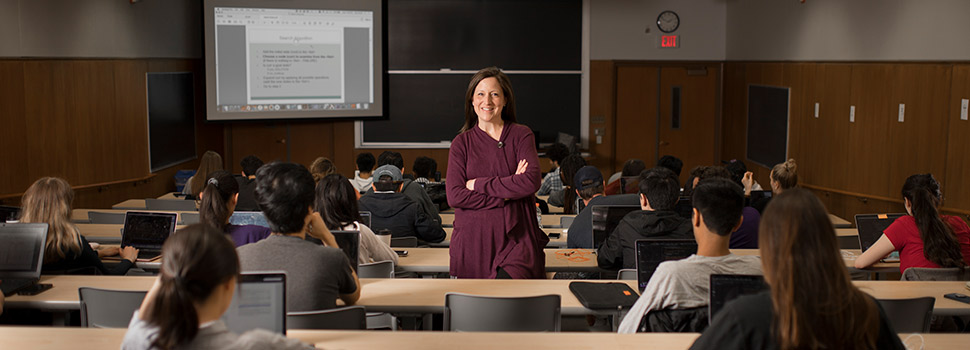“I care a lot about getting women in computer science, but I’m more interested in making the environment such that whoever wants to be in computer science can be in computer science. That will only happen if we create the right culture.”
Computer science professor Sara Sood is determined to increase the number of women and underrepresented groups in computer science. It’s no secret that computer science lacks gender and racial/ethnic diversity: Women held just 25% of computing jobs in 2015, and access to opportunities is still limited for black and Hispanic students. The demographics of the field have become a cultural trope: young, white men in zip-up hoodies. But Sood knows that interest in computer science spans all backgrounds, and she’s pushing to make the field more welcoming for everyone.

"The classroom can be a place where women and people who have less coding experience can get really discouraged," Sood says. "Especially because there are often students who ask questions like, 'I know how to program in 10 languages. For my startup that has angel funding, which of them should I use?' These are posturing, showing off questions, and they make other students feel like everyone here knows 10 languages, everyone has a startup, and you don't belong here if you don't."
No showing off
Sood now starts every course with a quick disclaimer: There will be no showing off here. If students have a question about their startup or side project, she will gladly meet them after class. Sood tells students that “Huh?” is a perfectly fair question, as is, “Can you repeat that?”
“In other classes, there are always people who brag or ask questions just to seem smart,” says Natalia Novoa, a first-year student from El Salvador who took her first computer science class at Northwestern. “But because Sara starts class with that disclaimer, nobody judges anyone and we’re all free to ask any question.”
In addition to setting the tone of the class up front, Sood encourages students to focus on their own success. This is a helpful piece of advice for students like Nolan Robinson, who was completely new to coding when he took a computer science class with Sara as a first-year student. He actually considered dropping Sara’s class — and computer science entirely — about midway through the quarter.

“Sara asked me to talk to her before I dropped the class, and when I went to her, she said, ‘No matter how hard something is, you’ll find a way to understand it if you love it,’” Robinson remembers. “She encouraged me to focus on my own learning, rather than comparing myself to other people in the class.”
Sood pushes students to focus on their own growth and trust their own abilities.
“It might take a student 10 hours a week to finish an assignment that takes their roommate 30 minutes,” Sood says. “That doesn’t mean that student shouldn’t be a computer scientist — it just means they’re climbing a steep learning curve.”
Robinson continues to climb, and is now a double major in theatre and computer science. Novoa recently switched her major to computer science.
Meeting a need
Interest in computer science among Northwestern students has surged in recent years, and underrepresented minorities are a growing share of the major. Women now make up about 30% of the university’s computer science major, up from 15% in 2011.
This growth and change are perhaps most obvious in CS111, the introductory-level computer science course offered through Northwestern’s McCormick School of Engineering. With up to 400 students taking CS111 per quarter, the course fills Northwestern’s largest lecture halls. Interested students span countless backgrounds.
“CS111 is required for computer science majors, but it’s also incredibly popular with non-majors,” says computer science professor Ian Horswill, who co-teaches CS111 with Sood. “It brings in students from all over the university — we have graduating seniors in violin and first-year students in theater working alongside students who took AP computer science or built computers in their basements. I like to say all the class requires is knowledge of how to use a web browser.”

Informed by research showing women and underrepresented groups are not interested in programming just to create flawless code, Horswill redesigned CS111, and subsequently relaunched the course with Sood in 2015, with an eye toward “purposeful programming”: coding to meet a need or solve a problem.
Under this model, students might work on programming aimed at helping elderly adults use mobile apps. Students would have to determine how these users interact with programs, and then use their coding skills to design apps to meet those unique needs. Designing systems to detect trolling and personal attacks in online forums, or to identify suicidal ideation on social media, are other examples of purposeful programming.
A space to fail
While the content of the course is focused on putting code to use outside the classroom, the structure is very much guided by the class itself — its size specifically. In order to ensure each of the several hundred students in CS111 receives individual attention and real-time feedback, Sood and Horswill hire undergraduate peer mentors each quarter, who meet weekly with a group of six students to work on an ungraded assignment based on the week’s lecture.
“The point is not to succeed on this assignment,” Horswill says. “The point is to have your early failures, which everyone will have, when there’s someone there to help you over those speed bumps. Then when you are at home in your dorm room working on the real assignment, it won't be as scary.”
Nida Pervez has been a peer mentor multiple times, and she keeps coming back to the job because she wants to help students struggling through CS111 as she did.

“As a mentor, I see myself in other students,” Pervez says. “I was in their shoes, and I can use my experience to help them and say, ‘I approached this problem the exact same way, but what I didn’t notice is that you could also try x, y and z, which might be a bit easier.’”
Novoa says mentorship from dedicated students like Pervez is one of the most helpful parts of the class.
“If the assignment was really hard, I’d go to office hours three times a week,” Novoa says. “I feel like it’s the best way to learn computer science. I still struggle, but it’s so fulfilling when you’re in that room and you finally get it.”
An upward trajectory
Horswill says there are many students who see coding as means to an end, and he says Northwestern can be the perfect launching pad for careers in coding and beyond.
“As a student, I was fascinated by the computer itself, and we certainly still have those students,” Horswill says. “But we also have lots of students who want to build software because they want to see it used in the world. And students who want to learn design skills and understand how to work in groups. Those are skills everyone needs, and they benefit the whole world.”
Whether students choose a career in computer science or not, helping students gain confidence in coding makes it all worth it for Sood.
“One of my favorite parts of CS111 is working with students who have never programmed before and thought it was intimidating or unapproachable and actually showing them that they can program,” Sood says. “It’s amazing to actually see the lightbulbs go off in their eyes as they get their first output printed to the screen.”


